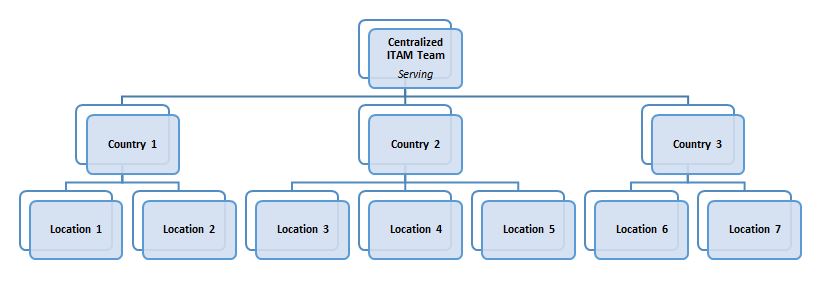
ITAM Basics: 5 Tips for Dealing with SAM Complexity Caused by Decentralized Organizations
IT asset management is a much-needed corporate capability – whether it be the effective management of hardware, software, or services. And different organizations will have different challenges based on a number of factors ranging from size to organizational complexity – including the global corporate structure.
There are thankfully various pieces of freely-available best practice guidance for organizations looking to start, or improve, their IT asset management (ITAM) capabilities and results. As part of this, there’s guidance on software asset management (SAM) – also called software license management (SLM) – which includes the practice of software license optimization (SLO). As a shameless plug – there are a number of additional, helpful ITAM pieces on my website.
Often though, the SAM guidance – while informative – can neglect the complexities of centrally managing software costs and compliance across decentralized organizations, i.e. organizations with people, software assets, and locations in different locations and countries. Often spread across all seven continents. It makes my head hurt just thinking about the complexity of such large, successful, organizations but hopefully the following image helps:
 So, to help deal with some of the additional SAM-complexity caused by such organizational decentralization, my blog offers up 5 related best practice tips.
So, to help deal with some of the additional SAM-complexity caused by such organizational decentralization, my blog offers up 5 related best practice tips.1. Create a Business Case for ITAM, SAM, and SLO Centralization
It might be an obvious thing to state but…
The complexity and the costs of centralized ITAM and SAM operations need to be outweighed by the anticipated benefits. Not only from a justification perspective, but also as a key motivator for all those involved (see tip #2).
So, consider the full spectrum of options – from fully centralized, through hybrid scenarios, to decentralized operations – rather than automatically opting for a centralized approach (to ITAM and SAM). And choose the most appropriate approach based on what’s ultimately best for your organization. You never know – a locally-operated, decentralized operation might actually work best for your decentralized organization.
Even if a fully-centralized ITAM operation isn’t the best option, believe me, the best practice tips I’m offering here are still applicable in getting everyone working together towards the common goals of reducing the total cost of ownership for assets and minimizing asset-related risks.
2. Drive Participation and Standardization Through Stakeholder Management
Having different organizational entities – such as overseas business units or location-specific companies – operating in a decentralized manner, and with local accountability, is of course going to complicate the introduction of centralized ITAM and SAM activities.
At first it will seem like a logistical nightmare, with so many locations, geographies, etc. Plus, there’s also local legislation and regulation to respect and potentially a technological-based spaghetti soup (when the relevant managed data repositories (MDRs) and feeds are considered). These MDRs could be Excel spreadsheets through to locally-run ITAM tools – think of them as asset registers.
But the first key to ITAM success is actually people related. With a need for effective stakeholder management, across the various entities, to drive and ensure the correct levels of participation.
Getting people onboard with centralized ITAM operations – from the board to those who will interact with them daily across multiple countries – requires organizational change management (OCM) capabilities and the need to adequately communicate the “What’s in it for me?” This will of course be helped if each entity is responsible, even if just notionally charged (i.e. their asset costs are reported but not billed), for the costs of the IT assets their business activities employ. They will then benefit from the lower costs a centralized ITAM (or SAM) team can achieve through its operations.
There will most likely be resistance from the decentralized organizations (as is seen with most organizational change), but the key response stance to take is that the individual entities, operating their own SAM capabilities, will not be able to benefit from centralized expertise and operational economies of scale. Plus, the parent organization will also most likely forgo the enterprise-wide visibility and negotiating power (for global software license agreements) offered by centralized ITAM, SAM, and SLO operations.
3. Understand How the Organization and Individual Entities Work
A centralized ITAM, or SAM, team attempting to set up global ITAM and/or license management capabilities without first understanding how different parts of the organization work is going to:
- Make assumptions that are untrue (either globally or locally)
- Overlook geographical “peculiarities” and needs
- Struggle to get local cooperation and participation
- Most likely fail to deliver an optimized service (both globally and locally)
In the case of software in particular, to help with these potential issues the centralized team therefore needs to:
- Understand and cater for a wide spectrum of license/contract ownership scenarios
- Work with a variety of global budget holders
- Understand and influence the global deployment and use of software
- Operate common standards (more on this later)
- Recognize that responsibility for some specialist types of software might be better left with the business entities that use them, for instance high-value, low-volume engineering software titles
4. Integrate with Key Global Systems for Data Interoperability
The corporate ITAM tool requires integrations with the organization’s global, and likely globally-dispersed, human resources (HR) systems, active directory services, and IT service management (ITSM)/IT help desk solutions (plus other IT data sources, such as network discovery tools). This is to ensure the accuracy and completeness of the data required to support centralized ITAM, SAM, and SLO.
A central repository for all assets (hardware, software, and services), location, employee, license entitlement, and contract data – plus potentially usage data – can then be used to:
- Drive down total asset costs through activities such as asset rationalization, SLO, product/supplier replacement, better-informed contract negotiations, and potentially “asset sweating” (which is where your organization uses assets for longer than planned – to save money – before replacing them)
- Ensure software license compliance – matching installs to procured licenses, reflecting the associated licensing models – and facilitate software vendor audits
- Enable IT support activities (whether local, global, or both)
- Meet other local and global regulatory and governance needs
5. Agree, Communicate, and Enforce Global ITAM and SAM Policies and Processes
The benefits of centralization don’t just relate to increased bargaining power and the global assurance of compliance. Standardization also offers additional key benefits – from process optimization (across cost, time, and quality) to ensuring that global policies consistently reflect business requirements.
At a lower level this will include using a single, centralized data repository or federated equivalent (as per tip #4) that sources requirements for information on software installations and usage – with it considered the “single source of truth” for all things software related. And a globally-standard way of packaging, installing, and removing software (unless local requirements have a legitimate reason to be different).
So that’s my five tips for better centralized ITAM, SAM, and SLO across decentralized organizations. What would you add? Please let me know in the comments.






